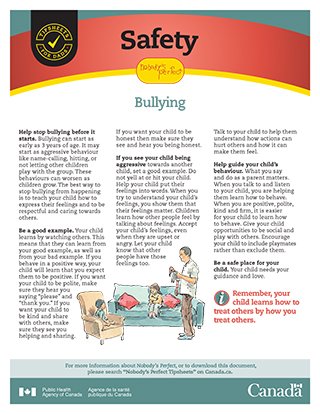Safety: Bullying

Download the alternative format (PDF format, 364 KB, 2 pages)
Organization: Public Health Agency of Canada
Help stop bullying before it starts. Bullying can start as early as 3 years of age. It may start as aggressive behaviour like name-calling, hitting, or not letting other children play with the group. These behaviours can worsen as children grow. The best way to stop bullying from happening is to teach your child how to express their feelings and to be respectful and caring towards others.
Be a good example. Your child learns by watching others. This means that they can learn from your good example, as well as from your bad example. If you behave in a positive way, your child will learn that you expect them to be positive. If you want your child to be polite, make sure they hear you saying “please” and “thank you.” If you want your child to be kind and share with others, make sure they see you helping and sharing. If you want your child to be honest then make sure they see and hear you being honest.
If you see your child being aggressive towards another child, set a good example. Do not yell at or hit your child. Help your child put their feelings into words. When you try to understand your child’s feelings, you show them that their feelings matter. Children learn how other people feel by talking about feelings. Accept your child’s feelings, even when they are upset or angry. Let your child know that other people have those feelings too. Talk to your child to help them understand how actions can hurt others and how it can make them feel.
Help guide your child’s behaviour. What you say and do as a parent matters. When you talk to and listen to your child, you are helping them learn how to behave. When you are positive, polite, kind and firm, it is easier for your child to learn how to behave. Give your child opportunities to be social and play with others. Encourage your child to include playmates rather than exclude them.
Be a safe place for your child. Your child needs your guidance and love.
Remember, your child learns how to treat others by how you treat others.
Fun & Easy Activities
Making a Kindness Tree
This activity will help children to see how ‘kindness’ can help grow from one simple leaf to an entire tree.
- Gather materials like colored paper, washable markers or crayons, scissors, tape, many bare tree branches, tall vase.
- Draw leaf shapes on the colored paper and cut out them out. (Depending on the age of your child, they can do this with you)
- Start your kindness tree by writing down an act of kindness on each leaf. For example: “I liked it when Kira hugged me before I left for work” or “Liam gave the baby a toy when she was crying”.
- Ask your child for some acts of kindness that they experienced. You or your older child can write on the leaves. Your younger child can draw a picture on their leaf.
- Tape the leaves onto the branches.
- Once your branch is complete, put it in a vase for all to see.
- Add branches to it weekly by acknowledging many examples of kindness until you have created a whole ‘kindness tree’.
Activity adapted from: PBS Parents – Crafts for Kids: Thankful Trees
The Public Health Agency of Canada gratefully acknowledges the collaboration and expertise of Dad Central Canada (www.dadcentral.ca) and their national network in the development of the Nobody’s Perfect tipsheets for dads.